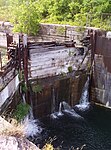Les Cèdres, Quebec
Designated places in QuebecGreater MontrealIncorporated places in Vaudreuil-Soulanges Regional County MunicipalityMunicipalities in QuebecPages with non-numeric formatnum arguments ... and 2 more
Quebec populated places on the Saint Lawrence RiverUse Canadian English from January 2023

Les Cèdres is a municipality located north of the Saint Lawrence River in the Montérégie of Quebec, Canada, near Vaudreuil-Dorion. The population as of the Canada 2021 Census was 7,184. The name means "The Cedars" in French. There is an extensive rapid on the St. Lawrence River at this location. During the American Revolution, the Battle of the Cedars was fought in the vicinity. In 1959-1960 Swedish writer, Stig Claesson, lived in the village at a place called Point Charlie and later wrote a book about it called My friend Charlie.
Excerpt from the Wikipedia article Les Cèdres, Quebec (License: CC BY-SA 3.0, Authors, Images).Les Cèdres, Quebec
Rue Sainte-Catherine,
Geographical coordinates (GPS) Address Nearby Places Show on map
Geographical coordinates (GPS)
| Latitude | Longitude |
|---|---|
| N 45.3 ° | E -74.05 ° |
Address
Rue Sainte-Catherine
Rue Sainte-Catherine
J7T 1B7
Quebec, Canada
Open on Google Maps







